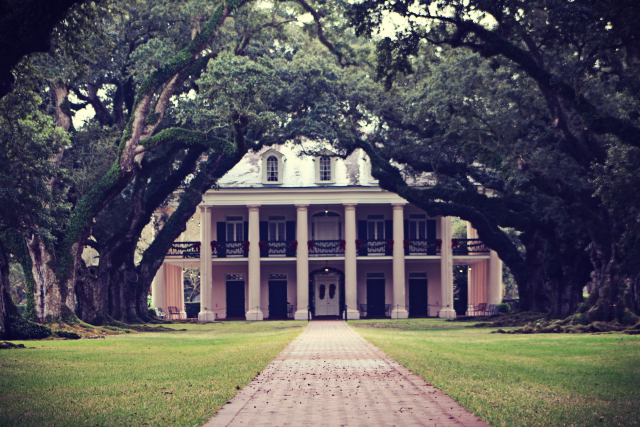While road-tripping through The River Parishes outside of New Orleans, it is easy to fall in love with the antebellum mansions that grace the shores of the Mississippi River, like Oak Alley. Each house is full of its own unique history, stories of triumph and of tragedy, of a world that no longer exists as it once did.
Often romanticized life in the early 1800s was a lot harder than it looked in the movies, but even so, there is something about these grand old houses. One of the most storied mansions along the river is Oak Alley, the iconic home used as the setting in many productions even Beyoncé has shot here, the home is still most recognized as the estate of Brad Pitt’s character Louis in the 1994 film Interview with the Vampire.
 |
| Inside the master bedroom |
The story of the grand oak trees that line the entrance to the Bon Séjour plantation, as it was called, is one of passion and the vision of sugar grower Jacques Roman. The mansion was completed in 1839 under the oversight of George Swainy and was most likely designed by architect and Roman’s father-in-law Joseph Pilié. For many years the official story was that the famous trees were planted over 100 years before the mansion was constructed, by some mysterious person lost to history, however, recently it was discovered that each tree was transplanted to its location when the home was constructed, a monumental task even today. Salves worked the fields, built the grand home, and transplanted the massive iconic oak trees that give the plantation its name.
 |
| The restored dining room of the main house, including the original fan. |
Oak Alley Post Civil War:
After the Civil War, the Roman family struggled to keep the property, and in 1866, the plantation was put up for auction. The estate sold several times over the years, and by the early 1920s, the home had fallen into disrepair and was not inhabitable. In 1925, Andrew Stewart purchased the property as a gift for his wife Josephine. She would go on to oversee the restoration and hired architect Richard Koch to restore and modernize the house, adding indoor plumbing and electricity. The Stewarts used the plantation as a cattle ranch until the 1960s, and upon Josephine’s death in 1972, the home was transferred to the Oak Alley Foundation to be opened to the public.
 |
| Breakfast at Oak Alley Restaurant |
Today, the historic home is a living museum that draws tens of thousands of tourists worldwide. The property also has a restaurant, bar, and gift shop. But most people don’t know that in addition to being a historic attraction, it is also a hotel. Tucked away behind the main section of the landmark estate, a series of cottages are available for guests. Each one has a little kitchenette, living room, and bedroom area, and ours even had a screened-in porch. Parking is directly next to your cottage, and room service is available if you order during restaurant hours. Cottages are generally between $225-$275 per night, depending on the season.
 |
| Cottage number 7 |
Education At Oak Alley:
Tours are available for $25 per person and include a guided tour of the mansion, which is restored and furnished with period-correct pieces. Moving outside Oak Alley doesn’t shy away from the subject of slavery and the role it played in plantation culture. Tours about the lives of the slaves who were in bondage at Oak Alley are also available, and I encourage you to go on both tours. Just a few dozen yards away from a grand mansion are fully reconstructed slave quarters and a detailed exhibit telling the stories of the men and women who were forced to live their lives as chattel.
 |
| Tour group taking in a historic tour of the slave quarters |
Other exhibits include a working blacksmith shop, a reconstruction of a Civil War-era officer’s field tent, and an exhibit on sugarcane that consists of a short film. Also, be sure to head over to the gift shop, where they have a great selection of books, art, food, and an ice cream shop.
During our stay over the holidays, the grounds were closed to the public for a day, but as a guest, we had access to the property even on holidays, they also encourage guests to tour the grounds at night and even provide flashlights. During the hours that the grounds are open, a short walk to the main property gives you access to all the amenities, and the on-site restaurant is excellent.
Oak Alley is an excellent location to explore the history of The River Parishes and a nice way to visit the city of New Orleans. While most people stay in the city and take a day trip to the plantations, making the city the day trip meant we could enjoy everything New Orleans had to offer and then enjoy a relaxing retreat in the country. Besides, Plantation Country has plenty to see, from touring historic plantations and museums to shopping and eating great food.
For more information or to book your stay at Oak Alley visit oakalleyplantation.com. Also, visit our Facebook Page for more photos.





















